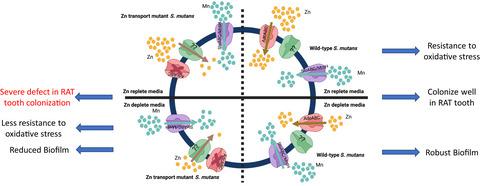当前位置:
X-MOL 学术
›
Mol. Oral Microbiol.
›
论文详情
Our official English website, www.x-mol.net, welcomes your
feedback! (Note: you will need to create a separate account there.)
Zinc import mediated by AdcABC is critical for colonization of the dental biofilm by Streptococcus mutans in an animal model
Molecular Oral Microbiology ( IF 2.8 ) Pub Date : 2021-04-05 , DOI: 10.1111/omi.12337 T Ganguly 1 , A M Peterson 1 , J K Kajfasz 1 , J Abranches 1 , J A Lemos 1
Molecular Oral Microbiology ( IF 2.8 ) Pub Date : 2021-04-05 , DOI: 10.1111/omi.12337 T Ganguly 1 , A M Peterson 1 , J K Kajfasz 1 , J Abranches 1 , J A Lemos 1
Affiliation

|
Trace metals are essential to all domains of life but toxic when found at high concentrations. Although the importance of iron in host–pathogen interactions is firmly established, contemporary studies indicate that other trace metals, including manganese and zinc, are also critical to the infectious process. In this study, we sought to identify and characterize the zinc uptake system(s) of Streptococcus mutans, a keystone pathogen in dental caries and a causative agent of bacterial endocarditis. Different than other pathogenic bacteria, including several streptococci, that encode multiple zinc import systems, bioinformatic analysis indicated that the S. mutans core genome encodes a single, highly conserved, zinc importer commonly known as AdcABC. Inactivation of the genes coding for the metal-binding AdcA (ΔadcA) or both AdcC ATPase and AdcB permease (ΔadcCB) severely impaired the ability of S. mutans to grow under zinc-depleted conditions. Intracellular metal quantifications revealed that both mutants accumulated less zinc when grown in the presence of a subinhibitory concentration of a zinc-specific chelator. Notably, the ΔadcCB strain displayed a severe colonization defect in a rat oral infection model. Both Δadc strains were hypersensitive to high concentrations of manganese, showed reduced peroxide tolerance, and formed less biofilm in sucrose-containing media when cultivated in the presence of the lowest amount of zinc that support their growth, but not when zinc was supplied in excess. Collectively, this study identifies AdcABC as the major high affinity zinc importer of S. mutans and provides preliminary evidence that zinc is a growth-limiting factor within the dental biofilm.
中文翻译:

AdcABC 介导的锌输入对于动物模型中变形链球菌在牙齿生物膜的定植至关重要
微量金属对生命的各个领域都至关重要,但在高浓度时会产生毒性。尽管铁在宿主与病原体相互作用中的重要性已得到充分证实,但当代研究表明,其他微量金属,包括锰和锌,对感染过程也至关重要。在这项研究中,我们试图鉴定和表征变形链球菌的锌摄取系统,变形 链球菌是龋齿的主要病原体,也是细菌性心内膜炎的病原体。与编码多个锌输入系统的其他致病细菌(包括几种链球菌)不同,生物信息学分析表明,变形链球菌核心基因组编码一个高度保守的锌输入系统,通常称为 AdcABC。编码金属结合 AdcA (Δ adcA ) 或 AdcC ATPase 和 AdcB 通透酶 (Δ adcCB ) 的基因失活严重损害了变形链球菌在缺锌条件下生长的能力。细胞内金属定量显示,当在亚抑制浓度的锌特异性螯合剂存在下生长时,两种突变体积累的锌都较少。值得注意的是,Δ adcCB菌株在大鼠口腔感染模型中表现出严重的定植缺陷。两种 Δ adc菌株都对高浓度的锰过敏,表现出过氧化物耐受性降低,并且当在支持其生长的最低量的锌存在下培养时,在含蔗糖的培养基中形成较少的生物膜,但当锌供应过量时则不会。总的来说,这项研究确定 AdcABC 是变形链球菌的主要高亲和力锌输入者,并提供了初步证据,证明锌是牙齿生物膜内的生长限制因素。
更新日期:2021-05-20
中文翻译:

AdcABC 介导的锌输入对于动物模型中变形链球菌在牙齿生物膜的定植至关重要
微量金属对生命的各个领域都至关重要,但在高浓度时会产生毒性。尽管铁在宿主与病原体相互作用中的重要性已得到充分证实,但当代研究表明,其他微量金属,包括锰和锌,对感染过程也至关重要。在这项研究中,我们试图鉴定和表征变形链球菌的锌摄取系统,变形 链球菌是龋齿的主要病原体,也是细菌性心内膜炎的病原体。与编码多个锌输入系统的其他致病细菌(包括几种链球菌)不同,生物信息学分析表明,变形链球菌核心基因组编码一个高度保守的锌输入系统,通常称为 AdcABC。编码金属结合 AdcA (Δ adcA ) 或 AdcC ATPase 和 AdcB 通透酶 (Δ adcCB ) 的基因失活严重损害了变形链球菌在缺锌条件下生长的能力。细胞内金属定量显示,当在亚抑制浓度的锌特异性螯合剂存在下生长时,两种突变体积累的锌都较少。值得注意的是,Δ adcCB菌株在大鼠口腔感染模型中表现出严重的定植缺陷。两种 Δ adc菌株都对高浓度的锰过敏,表现出过氧化物耐受性降低,并且当在支持其生长的最低量的锌存在下培养时,在含蔗糖的培养基中形成较少的生物膜,但当锌供应过量时则不会。总的来说,这项研究确定 AdcABC 是变形链球菌的主要高亲和力锌输入者,并提供了初步证据,证明锌是牙齿生物膜内的生长限制因素。











































 京公网安备 11010802027423号
京公网安备 11010802027423号